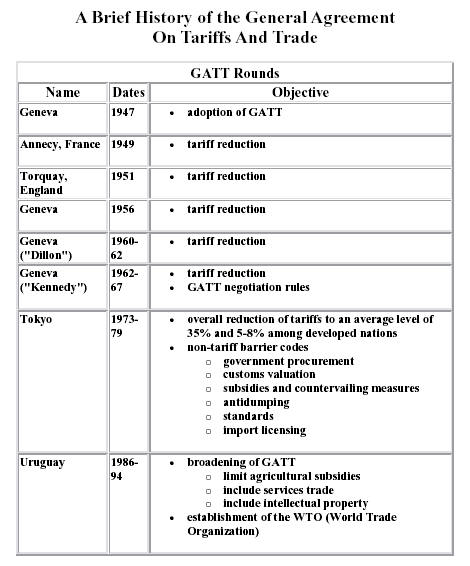IMF: International Monetary Fund:
"The IMF was created to promote internatioal monetary cooperation; to
facilitate the expansion and balanced growth of internatioal trade; to
promote exchange stability; to assist in the establishment of a multilateral
system of payments; to make its general resources temporarily available to
its members experiencing balance of payments difficulties under adequate
safeguards; and to shorten the duration and lessen the degree of
disequilibrium in the international balances of payments of members."
"The International Monetary
Fund (IMF or Fund) and the International Bank for Reconstruction and
Development (IBRD or World Bank) were both established at the United Nations
Monetary and Financial Conference, held at Bretton Woods, New Hampshire, on
July 1-22, 1944. The two were created to oversee stability in international
monetary affairs and to facilitate the expansion of world trade. Membership
in the World Bank requires membership in the IMF, and they are both
specialized agencies of the United Nations. The World Bank was given domain
over long-term financing for nations in need, while the IMF's mission was to
monitor exchange rates, provide short-term financing for balance of payments
adjustments, provide a forum for discussion about international monetary
concerns, and give technical assistance to member countries. These functions
are still generally true of both organizations, although the policies
determining how they are carried out have been modified and amplified over
time.
The Fund's legal authority is based on an international treaty called
the Articles of Agreement (Articles or the Agreement) which came into
force in December 1945. The first Article in the Agreement outlines the
purposes of the Fund and, although the Articles have been amended three
times in the course of the last 47 years prior to 1998, the first
Article has never been altered.
The IMF started financial operations on March 1, 1947. Drawings on Fund
reserves were made by 11 countries between 1947 and 1948, although there
were no drawings in 1950 and very few in the following years. During
this time the Fund worked on its drawings policies. One outcome was the
stand-by arrangements, established in 1952, modified in 1956, and
reviewed periodically since then. Stand-by arrangements provide a
procedure for drawing on Fund resources with conditions based on a
structural adjustment program for the borrower country. Stand-by
arrangements became the model for other lending procedures designed by
the Fund to meet the needs of its members.
By the mid-1970s, the Fund found itself becoming more of a lending
institution than originally envisioned. The Fund's ability to meet the
needs of its members was tested when the Organization of the Petroleum
Exporting Countries (OPEC) quadrupled the price of crude oil in
1973-1974. Prices were increased again in 1979 and in 1980. This altered
the international flow of funds as the OPEC countries' monetary reserves
accumulated rapidly. At the same time, the industrial countries
experienced strong inflationary pressures. These pressures were
addressed by an increase in interest rates and a reduction of imports.
This resulted in balance of payments deficits for many of the developing
countries, which were paying more for oil, paying higher interest rates
on the loans from the industrial countries, and finding reduced markets
for their exports. In response to this situation, the IMF created an Oil
Facility in 1974, and enlarged it in 1975, to aid members in balance of
payments difficulties. In addition, an Oil Facility Subsidy Account was
established for the poorest countries to alleviate the cost of borrowing
under the Oil Facility. During the 1970s, although the oil price shocks
placed more countries in balance of payments difficulties and forced
many of the developing countries to borrow not only against the Fund,
but also against private banks which were receiving a surplus of OPEC
petrodollars, it was generally perceived at the time that the debt cads
would be short-lived. It was not until Mexico threatened to default on
its loans in 1982 that the world monetary community realized the extent
and depth of the crisis. Throughout the 1980s the Fund played an
increasingly larger role, not only as "lender-of-last-resort," but also
as mediator with debtor countries in relation to creditor nations and
private banks.
In the mid-1980s the Fund's lending operations increased dramatically.
Stand-by arrangements are typically for one to three years, but the
exigency of the debt crisis caused the Fund to devise programs for
adjustment over longer periods. These are known as extended arrangements
and, with other medium-term programs, can be arranged through the
Structural Adjustment Facility or the Enhanced Structural Adjustment
Facility. The terms of a structural adjustment program, or stabilization
program, are known as conditionality. Programs include quantified
targets or ceilings for bank credit, the budget deficit, foreign
borrowing, external arrears, and international reserves. They also
include statements of policies that the member intends to follow.
Conditionality came under detailed scrutiny during the 1980s as more and
more developing countries adopted structural adjustment programs and
later were unable to meet the terms of the agreement. The philosophy of
the Fund was criticized as being too oriented to the industrial
economies and not adapted to developing economies. During the late-1980s
several plans were put forth, involving not only the Fund but the
creditor nations and commercial banks as well, to reduce the debt and
the debt service payments of the debtor nations. In 1989 the Fund
developed new debt reduction guidelines, providing Fund support for
commercial bank debt and debt service-reduction operations by member
countries. The debt strategy is still being assessed and its success or
failure has not been determined."
Overview
Susan Aaronson of the National Policy Association also
provides a brief explanation of how the World Trade
Organization came into being:
"The
Establishment of the WTO
By the late
1980s, a growing number of nations decided that GATT
could better serve global trade expansion if it became a
formal international organization. In 1988, the US
Congress, in the Omnibus Trade and Competitiveness Act,
explicitly called for more effective dispute settlement
mechanisms. They pressed for negotiations to formalize
GATT and to make it a more powerful and comprehensive
organization. The result was the World Trade
Organization, (WTO), which was established during the
Uruguay Round (1986-1993) of GATT negotiations and which
subsumed GATT. The WTO provides a permanent arena for
member governments to address international trade issues
and it oversees the implementation of the trade
agreements negotiated in the Uruguay Round of trade
talks
The WTO's Powers
The WTO is
not simply GATT transformed into a formal international
organization. It covers a much broader purview,
including subsidies, intellectual property, food safety
and other policies that were once solely the subject of
national governments. The WTO also has strong dispute
settlement mechanisms. As under GATT, panels weigh trade
disputes, but these panels have to adhere to a strict
time schedule. Moreover, in contrast with GATT
procedure, no country can veto or delay panel decisions.
If US laws protecting the environment (such as laws
requiring gas mileage standards) were found to be de
facto trade impediments, the US must take action. It can
either change its law, do nothing and face retaliation,
or compensate the other party for lost trade if it keeps
such a law (Jackson, 1994).
The WTO's Mixed
Record
Despite its
broader scope and powers, the WTO has had a mixed
record. Nations have clamored to join this new
organization and receive the benefits of expanded trade
and formalized multinational rules. Today the WTO has
grown 142 members. Nations such as China, Russia, Saudi
Arabia and Ukraine hope to join the WTO soon. But since
the WTO was created, its members have not been able to
agree on the scope of a new round of trade talks. Many
developing countries believe that their industrialized
trading partners have not fully granted them the
benefits promised under the Uruguay Round of GATT. Some
countries regret including intellectual property
protections under the aegis of the WTO.
Protests
A wide range
of citizens has become concerned about the effect of
trade rules upon the achievement of other important
policy goals. In India, Latin America, Europe, Canada
and the United States, alarmed citizens have taken to
the streets to protest globalization and in particular
what they perceive as the undemocratic nature of the WTO.
During the fiftieth anniversary of GATT in Geneva in
1998, some 30,000 people rioted. During the Seattle
Ministerial Meetings in November/December 1999, again
about 30,000 people protested, some violently. "
GATT and the Environment:
As the text
observes, the word "environment" appears nowhere in the
language of GATT. However, this is not the major source of
concern for those concerned over the fate of the
environment. For many environmentalists, the premise of GATT
- "free trade" - is what is most troublesome, for they
consider the term to be completely antithetical to
environmental preservation and protection. There is also
concern that the the Uruguay Round of GATT will undercut the
autonomy of the U.S. to enforce its national environmental
laws - subjecting these laws to the higher authority of the
WTO. The Uruguay Round of GATT was dedicated to the
principle of "non-discrimination" in trade practices across
national boundaries.
Articles
I and III of GATT requires Contracting Parties
(Signatory nations) "to treat imports no less favorably than
other imports and no less favorably than similar domestic
goods after border duties." The Uruguay Round also
mandated that "contracting parties" adopt policies and
practices "necessary to protect human, animal or plant life
or health" that "relate to the conservation of exhaustible
natural resource." Likewise, in the spirit of Article
XX of GATT, nations must furthermore "arbitrary or
unjustifiable discrimination between countries" and national
trade policies must not be a "disguised restriction on
international trade."
The
"root of the trade-environment" conflict within GATT
revolves around three environmental "categories" that affect
trade:
(1) measures
aimed at reducing the comparative advantage
gained by lax environmental laws in a foreign nation;
(2) Measures
aimed at protecting the domestic environment;
and
(3) Measures
aimed at protecting global resources.
Although
environmental
laws inherently contain a wide range of social and policy
choices, few would advocate the use of a supranational body
to make these choices. Concerns have been raised that the
WTO may be dangerously close to becoming such a body; i.e.,
because of the intertwining of the environment and trade."
This raises the additional concern regarding the extent to
which "trade related decisions .. directed
towards environmental measures are necessarily making
national environmental policy choices."
Upon thoroughly
review the provisions of GATT, particularly those related to
non-discriminatory trade and policy behavior on the part of
participating parties, Parks concludes that:
"The WTO is
incapable of making national environmental policy
choices. Such choices should be left to national bodies,
or in the case of global issues, to the international
consensus building process. ... The WTO and the
principle of non-discrimination are fully capable of
setting the outer-limits of acceptable rules and
behavior as countries create their own environmental
laws to suit their particular cultural and sociological
needs. Furthermore, contrary to the concern raised about
the loss of sovereignty and environmental rights in the
WTO, the WTO will be able to protect legitimate
environmental laws that benefit the environment, while
shielding the world trading system from protectionist
laws (or portions of those laws) that have little to do
with environmental preservation.
However, other
policy analysts see other potential environmental issues
associated with GATT. For instance,
Courtney Harold and C. Ford Runge of the University of
Minnesota have identified three issues that are of
particular concern:
-
"The
potential impacts of trade liberalization on the
environment:
Increased environmental degradation may result
from an increased volume of trade, increased consumption
levels, increased demands on natural resources, and
increased levels of waste production and pollution.
There is also concern that international differences in
environmental standards will result in "havens" for
pollution for industries seeking to avoid strict
environmental regulations. Comparatively, there is
concern that international bodies like WTO may
ultimately promulgate environmental protection standards
that are less comprehensive than those embraced by many
nations, resulting in the dilution of international
environmental regulations to the "lowest common
denominator."
-
The
possible use of environmental measures as non-tariff
barriers to trade: The major concern in this
regard is nations or trading blocs will use the excuse
of environmental health and safety to stymie free trade.
The fundamental problem in this regard is to
discriminate between legitimate environmental health and
safety concerns from those that serve to block trade
while masquerading as "environmental" issues.
-
The
relationship between trade agreements under NAFTA (the
North American Free Trade Agreement) and GATT and the
variety of international agreements affecting the
environment, such as the Montreal Protocol. The
variety of modern trade agreements all contain unique
features relative to trade and the environment. At issue
is "how" to rationalize these disparate requirements and
"who" or "which body" will oversee and negotiate these
differences.
The concerns
raised by Harold and Runge are contextualize against two
"axes" (1) between the U.S. and the other major world
economies in Europe and Asia and the Pacific and (2) between
the so-called "North" and "South."
In fact, there
have been a
number of environmental disputes
over GATT (and later under the auspices of WTO) to
include:


